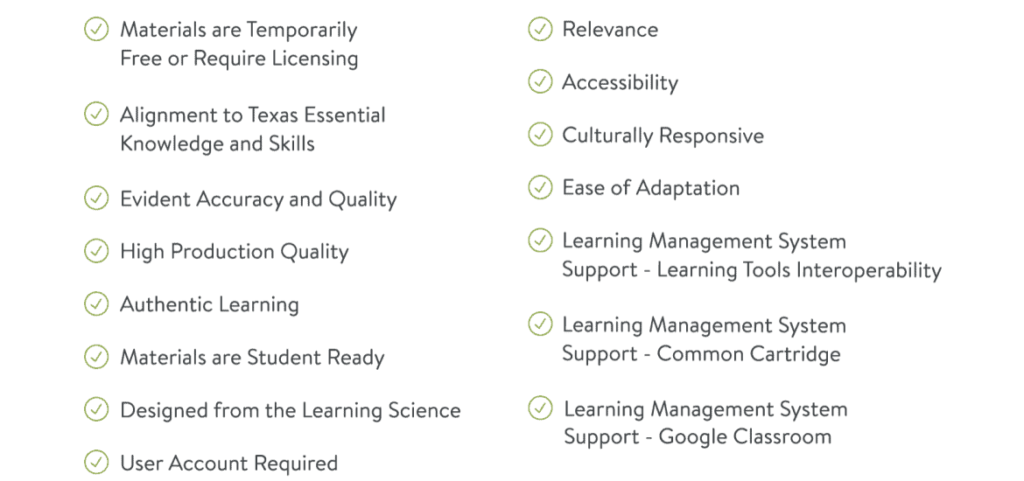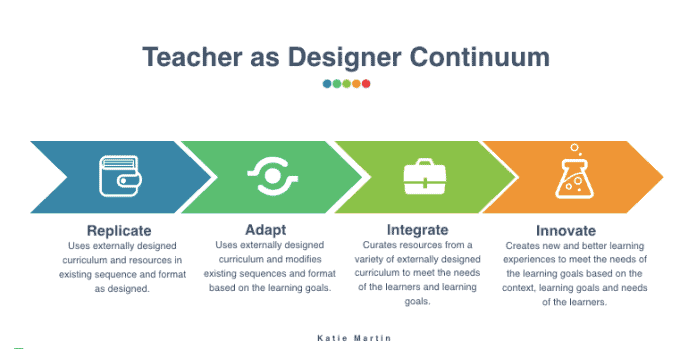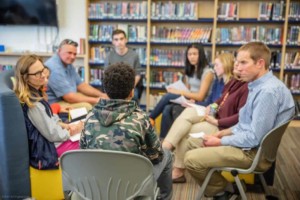Using OER to Increase Collaboration, Relevance, and Engagement

By: Katie Martin
As I connect with educators, I hear a common trend: many districts that moved from traditional textbooks to a robust digital ecosystem with devices, connectivity, learning platforms, and flexible (and digital) curriculum have fared much better as they navigate school closures, hybrid, and virtual learning. As many schools are facing the reality that they need to revert back to distance learning amidst building closures, there is a growing gap between districts that have access to high quality content and resources and those who have relied on the traditional textbooks. While some are seamlessly transitioning (the curriculum at least) from home to school due to the digital infrastructure, some are left with packets that are sent home for students to complete with little feedback, guidance, or relevance.
Despite our deepest desire to be back in schools, we know that students and teachers will likely have to engage from a distance as the numbers increase, which can be more efficient, relevant, and effective when resources are digital.
Empowering Teachers as Designers
As we navigate the shift toward digital ecosystems, there is great potential to use Open Educational Resources (OER) to ensure learning experiences continue to evolve with the world in real time. This shift in the resources used requires a shift in how many teachers plan, design, teach, and assess.
Empowering teachers as designers is critical but it can be overwhelming too. When I talk to teachers in districts that are replacing static textbooks with OER, the major challenges that they share include the following:
- Many teachers who have been teaching with prescribed curriculum have little to no preparation for curating and designing learning experiences in person or virtually.
- With much more flexibility and access to content, teachers struggle to evaluate content for alignment to standards and are not sure where to begin to look for quality resources.
- Without clear parameters, many feel uncertain about where they have flexibility to be innovative and where they don’t.
- Designing learning experiences in a Learning Management System and leveraging technology can be effective and efficient but requires new and different skills to maximize this potential.
In lieu of guidelines, resources, and time, teachers can revert back to old textbooks and teaching methods that aren’t designed to reach students in hybrid or virtual learning environments.
Teacher as Designer Continuum
Creating the high-quality foundation to build from is critical to supporting teachers in this important work. In my book, Learner-Centered Innovation, I describe how resources and frameworks allow for creativity and innovation when they provide the foundation—not the ceiling—for what teachers can build on, adapt, and innovate. Based on the context, the resources, and the desired learning goals, in a digital ecosystem, teachers should be able to leverage foundational resources across the following continuum to meet the needs of the learners:
- Replicate—Uses externally designed curriculum and resource in existing sequence and format as designed.
- Adapt—Uses externally designed curriculum and modifies existing sequences and format based on the learning goals and needs of students.
- Integrate—Curates resources from a variety of sources to meet the needs of the learners and learning goals.
- Innovate—Creates new and better learning experiences based on the context, learning goals, and needs of the learners.

Using OER to Increase Collaboration, Relevance, and Engagement
If we need people to think differently, solve problems, and be prepared for jobs that don’t exist, how can we structure learning experiences with the curriculum that is linear and standardized?
This case study by ASCD highlights how three districts increased relevance, collaboration, and engagement in their teachers and students through an innovative and collaborative project. “We used current information, including open educational resources,” said Erin English, Director of Blended and Online Learning for Vista. Open educational resources are licensed in such a way that educators can share, reuse, and adapt them to meet the needs of their students—a perfect vehicle for this project. In addition to developing units of study tied to standards and finding appropriate resources for activities, the COW (California, Ohio, and Wisconsin) teachers designed the specifications of a project through which students would demonstrate their learning.
As we are in the midst of the pandemic there is a tremendous opportunity to leverage the lessons throughout this project highlighted by ASCD to support teacher collaboration, leverage OER resources, and focus competency based assessment where students demonstrate what they learned.
Teacher Collaboration
Teachers, like all of us, have their own strengths and areas of growth. As we are all facing immense challenges and steep learning curves, there is no better time to support teacher collaboration to co-design projects and resources. Just like the teachers in the COW project, all teachers should be provided time to collaborate and leverage their strengths while benefiting others’ expertise to design meaningful learning experiences. Imagine if teachers worked together and some who were great at the project design could focus on that and curate resources while leveraging the most effective teaching strategies. Another educator who is great with the technology tools to engage learners can focus on that, while others might be great at explaining the content and some are great on small group settings. Could we reimagine how teachers work with students to lessen the load and increase the effectiveness and impact?
Open Educational Resources
Traditionally, curriculum has been organized in a linear path that promotes a one size fits all approach to success. When teachers are expected to follow directives or implement programs without taking the context and unique individuals in their room into consideration, it often creates frustration because they see their students need something else, something different, but don’t feel they have the authority to make those changes.
The Texas Learning Exchange curated an OER library to help educators find and use high quality and free resources to support meaningful learning anywhere, anytime.
Competency-Based Assessment
A standardized or traditional education system is designed to move kids along a certain path at a certain period of time and often ignores the variability in learners or their circumstances. In a mastery or competency-based system the learning goals are clear and transparent to the students and instruction, resources, learning experiences, and assessment are leveraged to meet the learner where they are and help them navigate their path.
This shift in assessment requires a different view of the role of the teacher, which shifts whole class lessons to more small group instruction, 1:1 check ins, and peer collaboration to move learners from their point A to their point B.
If you begin with your clear learning outcomes in step 1, some powerful tools for competency-based assessment are:
- Student goal setting and tracking
- Progress monitoring
- Student-led conferences
- Digital portfolio
The Impact of a Digital Ecosystem
Plans have been changed, revised, and remain short-sighted and week-by-week in many places. It is clear that our schools must evolve and create systems to meet learners. As I reflect on my own experiences and the countless educators I have observed and worked with, it is clear that the best teachers do not use a single approach or follow one curriculum; they create the context and experiences for diverse students to learn and grow. This video from Cajon Valley highlights the power of a robust digital ecosystem that helps teachers, students and families stay connected and engaged as they navigate learning from anytime, anywhere.
In the Curriculum, Instruction, and Assessment gear Future Ready highlights how, “Access to multimodal, multi-format, and multi-sourced high-quality academic content greatly improves learner experience and promotes equitable academic opportunities.” As described in the teacher as designer continuum, high-quality learning experiences that teachers can replicate should be the foundation that educators can use to collaborate and build from. Traditionally, curriculum has been organized in a linear path that promotes a one size fits all approach to success. Yet, this year has made it impossible to ignore that there is no standardized approach that will meet the needs of learners in 2020. It’s time to evolve.
This article was originally published here on katiemartin.com.
For more, see:
- 5 Ways OER Empower Teachers To Choose Their Own Classroom Adventure
- Getting Smart Podcast | The Role of OER in 21st Century Classrooms
- OER Curation at Scale: An Opportunity to Support Personalized Learning
Katie Martin is the VP of Professional Learning at Altitude Learning, where she works with educators and technologists to support partners with tools and support to create learning experiences that are designed to meet the needs of learners in a changing world. You can follow her on Twitter at @katiemartinedu.
Stay in-the-know with innovations in learning by signing up for the weekly Smart Update.







0 Comments
Leave a Comment
Your email address will not be published. All fields are required.